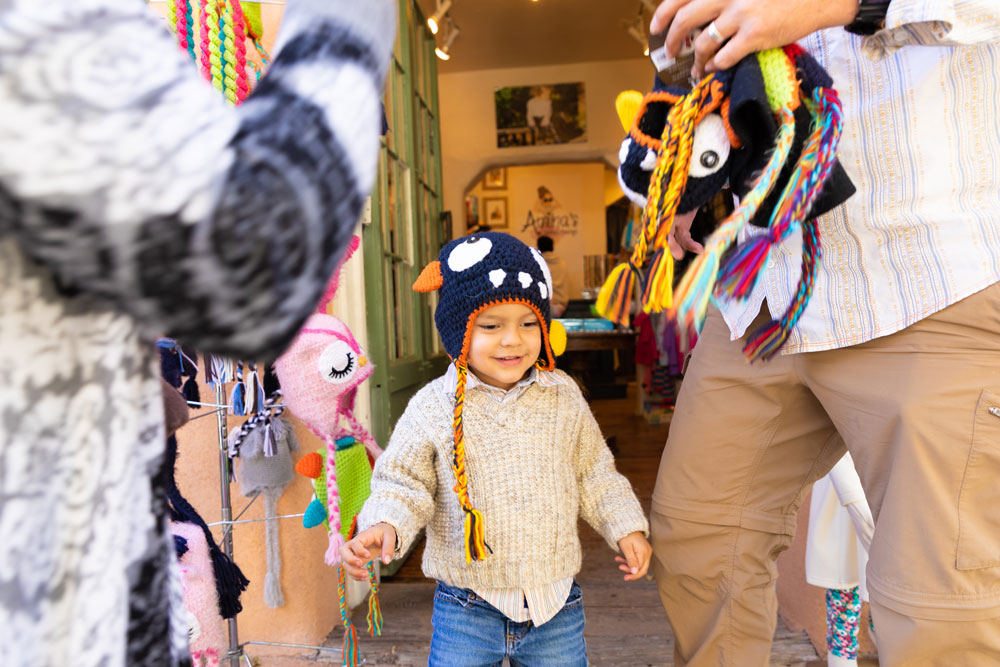
What To Do About Challenging Behavior?
Sometimes young children do things we wish they wouldn’t. This might be something you’ll laugh about when they’re older (like making “artwork” on the carpet with diaper cream) or behaviors that are just plain hard, like biting or kicking. Little ones learn a lot from how we respond to their actions, and Moments Together can help with some tips and suggestions for these tough caregiving moments.
We talked to Dr. Chelsea Morris, who is an assistant professor of early childhood at the University of New Mexico. She has years of experience working with families and preschool providers on challenging behavior. Plus, she has a 2-year-old, so she’s living this.
Dr. Morris divided her advice into three categories: Prevention, In the Moment, and After the Fact:
- Prevention means the steps caregivers can take to keep challenging behavior from happening in the first place. The more energy you spend here, the better. This means setting predictable routines for your little one that help reduce stress, as well as knowing what triggers tough behavior in your child and steering clear of those triggers as much as possible.
- In the Moment strategies are things you can do when a challenging behavior is happening or has just happened. These are about staying calm, naming the behavior, and keeping your child and others safe.
- After the Fact is when you can talk to your child about what happened, depending on their age, explain what you would like them to do next time, and give a simple explanation (not a lecture) about the reasons for your rules and expectations.
But we know (and Dr. Morris knows!) that this is easier said than done. So here are some examples of how to handle tough situations with young children of different ages.
Birth to 6 Months
Can infants even misbehave? Yes and no. Babies this young are not testing your boundaries or angling for a cupcake—that comes later. But you can still create conditions and routines that guide them toward behavior you like (adorable cooing) and away from behavior you don’t (pulling your hair with all their tiny might).
Prevention
At this age, prevention means setting predictable routines so your baby is getting enough sleep, enough to eat, and is dry and comfortable.
In The Moment
Remember that your baby is either learning about the world, or trying to communicate. At this age, babies cry because they are hungry, tired, uncomfortable or want connection with you. They pull your hair simply to see what will happen. Your number one strategy is to try to stay (outwardly) calm, even if you haven’t slept in three days, and try to meet your baby’s need. Never shake or spank them. If you can feel that you’re losing your cool, put your infant down in a safe place and take a break to calm yourself.
After The Fact
Your baby is too young for a heart-to-heart about your expectations. But take time to check in with yourself about how you’re feeling and whether you have the supports you need. If you’re feeling overwhelmed, New Mexico offers free home visiting support to any family in New Mexico with a new baby at no cost.
Six to 18 Months
Once your baby starts moving around, things change. Once they grow teeth, things change some more.
Prevention
Children in this stage are becoming more independent, and Dr. Morris said prevention is huge for this group: “I think the number one tip there is to remove situations that could result in bad behavior, so things like making sure your house is safe,” she said. You’re almost certainly going to end up yelling at your child if they pull down your grandmother’s collection of Precious Moments figurines, so make sure those are stored well out of reach. If your child can explore your home freely and safely, you’ll be in conflict with them less often.
In the Moment
All this prevention is important, and also it won’t always work. You will find yourself In the moment with your child, dealing with challenging behavior. If your child is hurting someone, remove them from the situation immediately and calmly. Use clear, simple words to describe what happened like, “I saw you bite, and biting isn’t safe.” Don’t impose extra consequences at this age, but a natural consequence might be that if a child bites at the playground, that means it’s time to leave and playtime is over. If the behavior is less serious, redirecting your child can be a good strategy (“Instead of unrolling all the toilet paper, let’s read a book.”)
After the Fact
After the fact teaching is limited at this age. Your child can’t easily connect a behavior in the morning with a consequence or conversation later in the day. But, you might find yourself dealing with challenging behaviors you don’t witness yourself, like an incident at daycare. In that case, Dr. Morris said you can work with your child’s teacher to understand the situation that led to the behavior and ideas for preventing it next time. If you do talk about the behavior with your child, consider doing an activity that creates empathy for a person who was harmed. For example, they could draw a picture for a child who was hurt by their actions.
Two to Three Years
Now we’re at the age where real tantrums can start—and the stage Dr. Morris is currently living in. She has a PhD in early childhood behavior and still finds this hard, so you’re in good company. At the risk of repeating ourselves, Prevention is still a lot about setting predictable routines.
Prevention
“The more predictable an environment is, the less behavior you’re going to see,” said Dr. Morris. Children at this age are seeking independence and control, and you can help them by giving them choices. Let them choose between their purple and orange shirts in the morning, or put their plates on a low shelf and let them pick their dinner plate. Make sure to limit their choices to options you’re OK with (Don’t say, “Should we go to the store?” if you aren’t OK with not going).
In the Moment
You can sometimes avoid a full-blown meltdown if you’re watching your child’s body language. Dr. Morris said you can say something like, “I can see that you are getting upset. Your shoulders are telling me that this is making you feel bad … Let’s take a deep breath. Let’s pick something from our Calm Down Box.” What’s a Calm Down Box? We had the same question. Dr. Morris said it’s a spot for things that might mellow your child, like a squishy ball, a favorite stuffed toy, or a water bottle with glitter in it that looks cool when you shake it. Sounds good. But what if you missed the moment when your child’s shoulders started to tense, and now they’re throwing a toy across the room? Dr. Morris said mid-meltdown is a terrible time to try to teach your child something. They are too distressed to listen or learn, and your job is to keep them safe and be with them while they calm down. Which they will.
After the fact
When your child is fully calm, you can have a short conversation with them about their feelings. Don’t lecture, but help them name the feelings behind their actions and come up with strategies for next time. Were they feeling angry? What were they angry about? What could they try next time it happens? Emphasize what you want your child to do, not what you don’t want them to do. So, you might say, “Next time someone is in your space, you can tell them to stop and move to another part of the playground.” You can even practice doing this, so your child feels ready for next time.
Four to Five Years
Now, according to Dr. Morris, your chickens are coming home to roost. Children’s behaviors at 4 and 5 depend a lot on whether they’ve been taught to name and manage their emotions in those earlier years. But, it’s not too late! Your reactions and choices still have a huge influence on your child’s behavior.
Prevention
At this stage, your prevention strategies can be more complex. Now children can respond well to a behavior chart where they earn stickers or other rewards for good behavior or completing tasks. You can read books about characters with different behaviors and talk about them, or plan some strategies in advance before a long day of travel.
But you’re still going to get tough behaviors. Depending on your kid, this might include meltdowns, whining (so much whining), or physical behaviors like throwing or shoving.
In the Moment
The advice here is going to sound familiar: Stay calm, keep your child safe, and help them calm down without caving in to their demands. Luckily, with older children you may be able to talk to them more easily about what is upsetting them and get to the root of the problem.
After the Fact
Talking with your child after the fact is helpful at this stage, because they’re old enough to reflect on the past. After they are calm, you can sit together, come up with ideas for next time, and remind them of your rules and expectations. Children this age can connect their actions with consequences, too, but consequences should still be logically connected to their behavior. This might mean that if they spent 30 minutes refusing to take a bath, there now isn’t time for fun playtime in the tub and the bath has to be all business.
Some Don’ts
Dr. Morris also named some common approaches that just don’t work:
Physical discipline, like hitting or shaking a child, is never recommended by early childhood experts and won’t improve their behavior in the long run. A child might fall in line the first time you spank them, but in the long run it teaches them that hitting is sometimes OK, and doesn’t teach them to understand and manage the root causes of their behavior.
Yelling is another approach that experts have found does more harm than good. Although many adults grew up with yelling, a caregiver who is yelling tends to make a child more upset and makes it harder for them to calm down and move on from a meltdown or misbehavior. And if it happens a lot, they tune it out.
Bluffing will only work at first. If you’re trying to leave the park and your child won’t come with you, resist the urge to say, “OK, I’m just going to leave you here!” This undermines your credibility with your child, who either knows you won’t do it, or will soon learn that you won’t do it. And then you’re back to the hard work of staying calm and labeling your emotions.

Need Some Help?
New Mexico offers free home visiting to all families in New Mexico from pregnancy to age 5. A home visitor is a trained expert who will come to your home and offer guidance, connection to resources, and a supportive ear. Unfamiliar with home visiting? Here’s a show that shares more about the program.
Did you find this article helpful?
Subscribe to Bright By Text to get more free tips and resources for your child’s journey, right to your phone!
